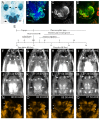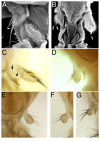The Noncell Autonomous Requirement of Proboscipedia for Growth and Differentiation of the Distal Maxillary Palp during Metamorphosis of Drosophila melanogaster
- PMID: 28357140
- PMCID: PMC5357526
- DOI: 10.1155/2017/2624170
The Noncell Autonomous Requirement of Proboscipedia for Growth and Differentiation of the Distal Maxillary Palp during Metamorphosis of Drosophila melanogaster
Abstract
The Drosophila maxillary palpus that develops during metamorphosis is composed of two elements: the proximal maxillary socket and distal maxillary palp. The HOX protein, Proboscipedia (PB), was required for development of the proximal maxillary socket and distal maxillary palp. For growth and differentiation of the distal maxillary palp, PB was required in the cells of, or close to, the maxillary socket, as well as the cells of the distal maxillary palp. Therefore, PB is required in cells outside the distal maxillary palp for the expression, by some mechanism, of a growth factor or factors that promote the growth of the distal maxillary palp. Both wingless (wg) and hedgehog (hh) genes were expressed in cells outside the distal maxillary palp in the lancinia and maxillary socket, respectively. Both wg and hh were required for distal maxillary palp growth, and hh was required noncell autonomously for distal maxillary palp growth. However, expression of wg-GAL4 and hh-GAL4 during maxillary palp differentiation did not require PB, ruling out a direct role for PB in the regulation of transcription of these growth factors.
Conflict of interest statement
The authors have no competing interests.
Figures







Similar articles
-
Genetic characterization of the role of the two HOX proteins, Proboscipedia and Sex Combs Reduced, in determination of adult antennal, tarsal, maxillary palp and proboscis identities in Drosophila melanogaster.Development. 1997 Dec;124(24):5049-62. doi: 10.1242/dev.124.24.5049. Development. 1997. PMID: 9362475
-
Wnt gene regulation and function during maxillary palp development in Drosophila melanogaster.Dev Biol. 2020 Jun 1;462(1):66-73. doi: 10.1016/j.ydbio.2020.03.012. Epub 2020 Mar 27. Dev Biol. 2020. PMID: 32229133
-
Analysis of Drosophila proboscipedia mutant alleles.Genome. 2004 Jun;47(3):600-9. doi: 10.1139/g03-133. Genome. 2004. PMID: 15190377
-
Analysis of murine HOXA-2 activity in Drosophila melanogaster.Dev Genet. 1999;24(3-4):336-44. doi: 10.1002/(SICI)1520-6408(1999)24:3/4<336::AID-DVG17>3.0.CO;2-R. Dev Genet. 1999. PMID: 10322642
-
T-box genes organize the dorsal ventral leg axis in Drosophila melanogaster.Fly (Austin). 2010 Apr-Jun;4(2):159-62. doi: 10.4161/fly.4.2.11251. Epub 2010 Apr 18. Fly (Austin). 2010. PMID: 20215860 Review.
Cited by
-
Segmental origins of the Drosophila eye-antennal disc: fission not fusion.Genetics. 2023 Jan 12;223(1):iyac168. doi: 10.1093/genetics/iyac168. Genetics. 2023. PMID: 36370072 Free PMC article. No abstract available.
References
-
- Snodgrass R. E. Principles of Insect Morphogenesis. New York, NY, USA: McGraw-Hill Book Co.; 1935.
LinkOut - more resources
Full Text Sources
Other Literature Sources
Molecular Biology Databases

